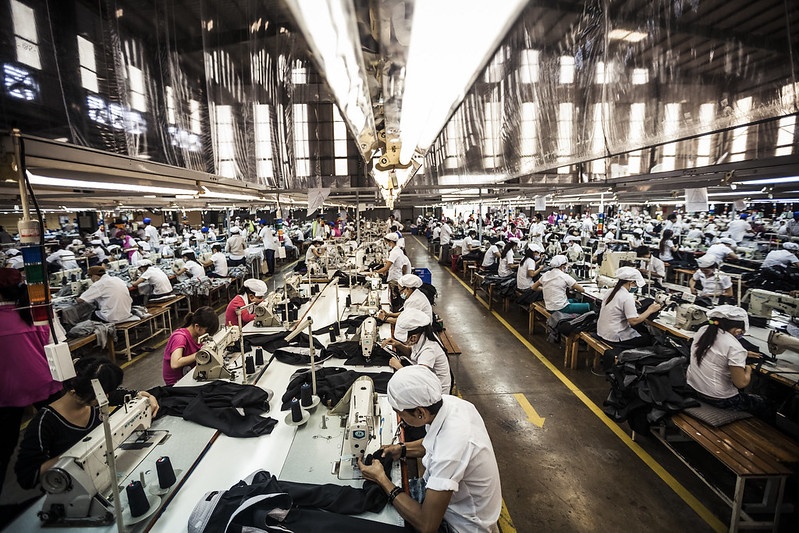20 June, 2024The textile and garment industry, an important sector employing more than 400 million people globally, faces significant changes due to climate change and the twin green and digital transitions. The challenges facing textile workers and what is needed to ensure a just transition amid these shifts was the topic of a webinar hosted by IndustriALL Global Union, the ITUC Just Transition Centre and IndustriAll Europe on 18 June.
Stakeholders from the European Commission, the ILO, Swedish clothing giant H&M and unionists from around the world shared their perspectives on a changing textile and garment industry, where the primary focus has shifted from post-Rana Plaza collapse health and safety concerns to addressing climate change and the rise of ultra-fast fashion through sustainability and circularity.
An increasing number of governments and brands are adopting circularity and sustainability goals, and are introducing measures to important resources such as water and energy. This green shift is often accompanied by new technologies which changes job roles and requires new skills. However, workers can only acquire new skills and get these new ‘’green and digital’’ jobs if there are systems in place for training for the jobs to come.
Mikael Garellick, senior adviser at the European Commission on the textiles sector, highlighted the EU's dual role as a major exporter and importer of textiles and clothing. The EU textiles strategy contains 16 pieces of EU legislation that will impact all textile products placed on the EU market. This new legislation, like the introduction of eco-design regulations and a ban on destroying unsold clothes, is a step towards sustainability and hopes to change textile manufacturing worldwide.
Facing a skills challenge, Casper Edmonds head of unit extractives, energy and manufacturing, focal point for the circular economy at the ILO, emphasized that solutions must be human-centred, stressing the need to prioritize people in the industry, ensuring workers remain part of its future. There is a risk that the shift to a service-oriented industry might lead to job losses in what is now well-organized sectors, pushing workers into less regulated environments.
“We risk losing real good union jobs and will have to fight for our fundamental rights again,”
said Casper Edmonds.
“All workers in the industry have a right to a healthy and safe working environment, and new technology brings new health and safety issues. Unions play a crucial role and need to continue to organize, including workers in jobs created by the circular economy.”
Union organization is crucial, especially in the newly created jobs within the circular economy. The ILO guidelines advocate for full cooperation between employers and governments to ensure worker rights and safety. This sentiment was echoed by Hannah Croner from H&M's sustainability department, which has set ambitious targets to reduce greenhouse gas emissions by 90 per cent by 2040.
The transition must not exacerbate existing vulnerabilities; poverty is a risk to prosperity everywhere and addressing it is crucial for a truly sustainable future. Women and migrant workers, key to circularity, are particularly at risk. Bangladeshi union leader Kalpona Akter insisted that we need a transition that includes living wages and social protection to prevent exacerbating poverty.
Regional insights highlighted diverse challenges. In Bangladesh, SM Morshed of the OSHE Foundation noted a lack of understanding among stakeholders. For the MENA region, policy expert Diana Kaissy pointed out issues like water scarcity presenting a challenge for the industry. Marta Zaldaña, regional coordinator of unions in the textile sector in El Salvador, underscored that green factories do not always equate to green jobs. In Nigeria, the prevalence of second-hand clothing poses a threat to the local industry, while in Sudan and in Latin America and the Caribbean, labour rights and water scarcity remain pressing issues.
“A just transition in the textile and garment industry requires a multifaceted approach. Environmental measures must be accompanied by social measures to address informality and ensure a comprehensive transition,”
said Diana Kaissy.
Concluding the webinar, the first of two on Just Transition in the textile and garment industry, Diana Junquera Curiel, co-director at ITUC Just Transition Center, said:
“The path to a just transition in this industry is complex and varies across regions. A unified effort focusing on sustainability, workers’ rights and inclusive growth can lead to a more equitable and resilient textile and garment industry.”
Photo credit: Work at a garment factory in the outskirt of HCM City, Viet Nam. © ILO/Aaron Santos



